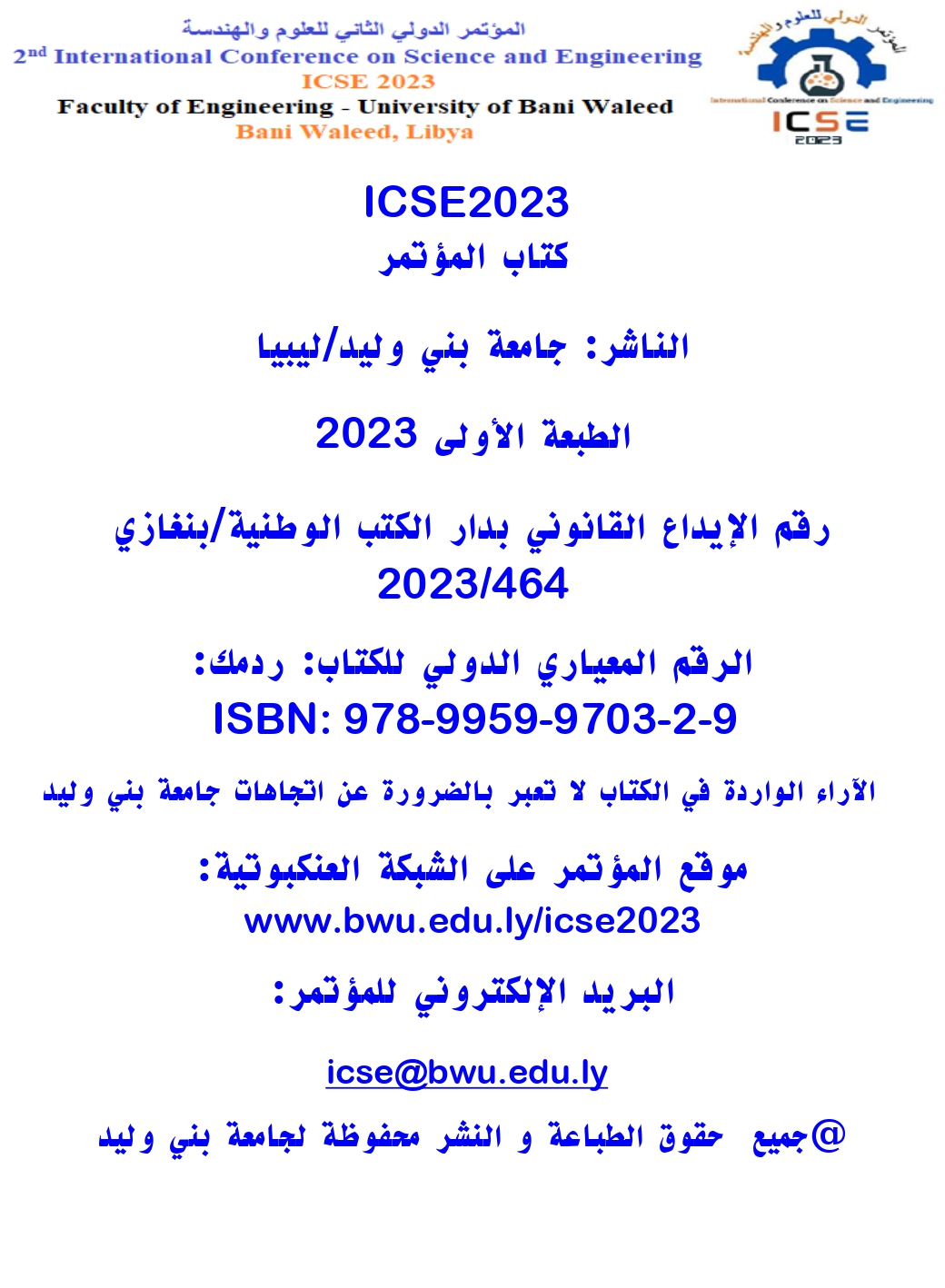A comparative study on the long-term microstructure of soil stabilisation with calcium and magnesium-based binders.
DOI:
https://doi.org/10.58916/jhas.v8i3.169الكلمات المفتاحية:
Ettringite، sulfate، ettringite carbonation، lime، Portland cement، magnesium oxideالملخص
Abstract: Analytical and microstructure investigations such as x-ray diffraction (XRD), derivative thermogravimetric (DTG), and scanning electron microscopy (SEM) among others, are typically used by researchers to detect and quantify the amount of formed minerals including ettringite minerals in gypseous soil treated with lime or cement. However, the detection of ettringite crystals is sometimes difficult, suggesting that the appearance of ettringite under the microstructure analysis is also dependent on the curing and experimental procedure. Therefore, a series of soil mixtures designed by use of two different soils (pure kaolin soil and artificial gypseous kaolin soil) and stabilised with 10 wt% of lime-L, cement-C and MgO-M, were investigated using multi-scale investigations including XRD, DTG and SEM. Accordingly, the result revealed that, under 90-days of moist curing, the key minerals detected in gypseous kaolin stabilised with calcium-based stabiliser are kaolinite, calcium silicate hydrate, portlandite, and ettringite, whereas only kaolinite, gypsum, brucite and magnesium silicate hydrate were detected in gypseous kaolin stabilised with magnesium oxide. However, under 200-days of water soaking period, no trace of gypsum, ettringite and portlandite were detected in the XRD of 10L- and 10C-based specimens, accompanied by the indication of new minerals (hemihydrate, anhydrite, calcite, and aragonite), suggesting the carbonation of ettringite during the soaking in water.
التنزيلات
المراجع
Al-Atroush, M.E., and Sebaey, T.A., (2021), Stabilization of expansive soil using hydrophobic polyurethane foam: A review., Transportation Geotechnics., 27, 100494. DOI: 10.1016/j.trgeo.2020.100494.
Millán-Corrales, G., González-López, J.R., Palomo, A., and Fernandez-Jiménez, A., (2020), Replacing fly ash with limestone dust in hybrid cements., Construction and Building Materials., 243, 118169. DOI: 10.1016/j.conbuildmat.2020.118169.
Nigam, S.K., Sinha, A.K., and Madan, S.K., (2023), Characterisation of stabilised red mud waste material for road infrastructure., Materials Today: Proceedings. DOI: 10.1016/j.matpr.2023.06.229.
Salehi, M., Bayat, M., Saadat, M., and Nasri, M., (2023), Prediction of unconfined compressive strength and California bearing capacity of cement-or lime-pozzolan-stabilised soil admixed with crushed stone waste., Geomechanics and Geoengineering., 18(4), 272-283. DOI: 10.1080/17486025.2022.2040606.
Chenarboni, H.A., Lajevardi, S.H., MolaAbasi, H., and Zeighami, E., (2021), The effect of zeolite and cement stabilization on the mechanical behavior of expansive soils., Construction and Building Materials., 272, p.121630. DOI: 10.1016/j.conbuildmat.2020.121630.
Orazi, M., Orazi, U.S., Romeo, E., Van Rompaey, G., and Tebaldi, G., (2023), Mechanical recovery of lime-stabilised clays subjected to freeze–thaw damage., Road Materials and Pavement Design., 24(8), pp.2104-2112. DOI: 10.1080/14680629.2022.2117070.
Saleem, A., ur Rehman, Z., Qamar, S., Katubi, K.M., Khan, A.H., Akhtar, M.N., Qamar, N., Alrowaili, Z.A., Saeed, U., Ullah, S., and Assiri, M.A., (2023), Investigations of graphene oxides and cement on strength performance of soil., Journal of Building Engineering., 73, 106857. DOI: 10.1016/j.jobe.2023.106857.
Jeremiah, J.J., Abbey, S.J., Booth, C.A., and Kashyap, A., (2023), Behaviour and Microstructural Characteristics of Lime-GGBS-Treated Kaolin Clay Contaminated with Gypsum., Materials, 16(2), 874. DOI: 10.3390/ma16020874.
Park, S., Ma, J., Yun, T.S., Jeon, S., Byeun, Y., Kang, D., and Jang, J., (2020), Pore-scale swelling mechanism of magnesium oxide granules during hydration., Construction and Building Materials., 251, 119101. DOI: 10.1016/j.conbuildmat.2020.119101.
Vitale, E., Deneele, D., Russo, G., and Ouvrard, G., (2016), Short-term effects on physical properties of lime treated kaolin., Applied Clay Science., 132, 223-231. DOI: 10.1016/j.clay.2016.04.025.
Pallanza, A., To, P., and Matheson, M., (2023), Lime stabilised road batters: A laboratory simulation of site flood conditions using a customised erosion apparatus and sample digitisation., Transportation Geotechnics., 40, 100975. DOI: 10.1016/j.trgeo.2023.100975.
Kinuthia, J.M., and Nidzam, R.M., (2011), Towards zero industrial waste: Utilisation of brick dust waste in sustainable construction., Waste Management., 31(8), 1867-1878. DOI: 10.1016/j.wasman.2011.03.020.
Seco, A., Del Castillo, J.M., Espuelas, S., Marcelino, S., and García, B., (2022), Sulphate soil stabilisation with magnesium binders for road subgrade construction., International Journal of Pavement Engineering., 23(6), 1840-1850. DOI: 10.1080/10298436.2020.1825711.
Xu, B., and Yi, Y., (2022), Stabilisation/solidification of lead-contaminated soil by using ladle furnace slag and carbon dioxide., Soils and Foundations, 62(5), 101205. DOI: 10.1016/j.sandf.2022.101205.
Seco, A., Miqueleiz, L., Prieto, E., Marcelino, S., García, B., and Urmeneta, P., (2017), Sulfate soils stabilization with magnesium-based binders., Applied Clay Science., 135, 457-464. DOI: 10.1016/j.clay.2016.10.033.
Li, W., Yi, Y., and Puppala, A.J., (2020), Suppressing ettringite-induced swelling of gypseous soil by using magnesia-activated ground granulated blast-furnace slag., Journal of Geotechnical and Geoenvironmental Engineering., 146(7), 06020008. DOI: 10.1061/(asce)gt.1943-5606.0002292.
Chemeda, Y.C., Deneele, D. and Ouvrard, G., (2018), Short-term lime solution-kaolinite interfacial chemistry and its effect on long-term pozzolanic activity., Applied Clay Science., 161, 419-426. DOI: 10.1016/j.clay.2018.05.005.
Choobbasti, A.J., and Kutanaei, S.S., (2017), Microstructure characteristics of cement-stabilized sandy soil using nanosilica., Journal of Rock Mechanics and Geotechnical Engineering., 9(5), 981-988. DOI: 10.1016/j.jrmge.2017.03.015.
Kinuthia, J.M. and Wild, S., (2001), Effects of some metal sulfates on the strength and swelling properties of lime-stabilised kaolinite., International Journal of Pavement Engineering., 2(2), 103-120. DOI: 10.1080/10298430108901720.
Ebailila, M., Kinuthia, J., and Oti, J., (2022), Suppression of Sulfate-Induced Expansion with Lime–Silica Fume Blends., Materials., 15(8), 2821. DOI: 10.3390/ma15082821.
Puppala, A.J., Intharasombat, N., and Vempati, R.K., (2005), Experimental studies on ettringite-induced heaving in soils., Journal of Geotechnical and Geoenvironmental Engineering., 131(3), 325-337. DOI: 10.1061/ASCE1090-02412005131:3325.
Aldaood, A., Bouasker, M., and Al-Mukhtar, M., (2014), Free swell potential of lime-treated gypseous soil., Applied Clay Science., 102, 93-103. DOI: 10.1016/j.clay.2014.10.015.
Jha, A.K., and Sivapullaiah, P.V., (2016), Volume change behavior of lime treated gypseous soil—influence of mineralogy and microstructure., Applied Clay Science., 119, pp.202-212. DOI: 10.1016/j.clay.2015.09.017.
Al-Mukhtar, M., Lasledj, A., and Alcover, J.F., (2014), Lime consumption of different clayey soils., Applied Clay Science., 95, 133-145. DOI: 10.1016/j.clay.2014.03.024.
Ebailila, M., Kinuthia, J., and Oti, J., (2022), Role of Gypsum Content on the Long-Term Performance of Lime-Stabilised Soil., Materials., 15(15), 5099. DOI: 10.3390/ma15155099.
BS EN 197-1:2011, Cement — Part 1: Composition, specifications and conformity criteria for common cements, BSI Standards Limited, London, UK, 2011. https://doi.org/10.3403/30205527.
Adeleke, B.O., Kinuthia, J.M., Oti, J., and Ebailila, M., (2023), Physico-mechanical evaluation of geopolymer concrete activated by sodium hydroxide and silica fume-synthesised sodium silicate solution., Materials., 16(6), 2400. DOI: 10.3390/ma16062400.
M. Ebailila, Sulfate soil stabilisation with silica fume-based binders, Doctoral Thesis, University of South Wales, England, UK, 2022.
Vakili, M.V., Chegenizadeh, A., Nikraz, H., and Keramatikerman, M., (2016), Investigation on shear strength of stabilised clay using cement, sodium silicate and slag., Applied Clay Science., 124, 243-251. DOI: 10.1016/j.clay.2016.02.019.
Ahmed, A., (2015), Compressive strength and microstructure of soft clay soil stabilized with recycled bassanite., Applied clay science., 104, 27-35. DOI: 10.1016/j.clay.2014.11.031.
Aldaood, A., Bouasker, M. and Al-Mukhtar, M., (2014), Impact of wetting–drying cycles on the microstructure and mechanical properties of lime-stabilized gypseous soils., Engineering Geology., 174, 11-21. DOI: 10.1016/j.enggeo.2014.03.002.








